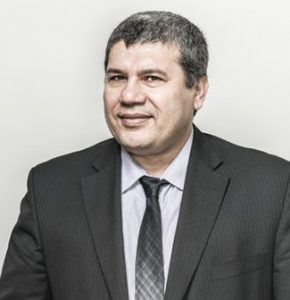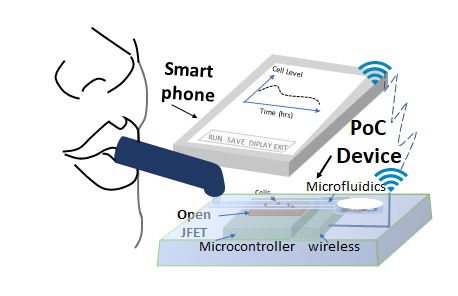Using microelectronics, machine learning and samples of saliva, a team of researchers led by York University Professor Ebrahim Ghafar-Zadeh (Lassonde School of Engineering) is working to develop a new technology that would detect symptoms of COVID-19 infection – even in those who present as asymptomatic.

Working with Professor Micheal Gogauer (University of Toronto), Professor Amir Sanati Nezhad (University of Calgary), as well as students (Abbas Panahi, Hamed Osouli Tabrizi), a research assistant (Negin Mansourifat) and a postdoctoral Fellow (Shahin Ebrahimi) at York University, Ghafar-Zadeh is investigating the development of fast, reliable and inexpensive testing that requires only a simple saliva test. The work is being performed at York University’s Biologically Inspired Sensors and Actuators Laboratory (BioSA).
The research team, initially joining together to research periodontal and cardiovascular diseases, quickly pivoted their focus to the SARS-CoV-2 virus when the pandemic struck, earning support from CIHR (Canadian Institutes of Health Research), Mitacs, SOSCIP (Smart Computing for Innovation), Google and CMC Microsystems.
The technology aims to provide near-instant, on-the-spot results, said Ghafar-Zadeh, adding the team hopes hopes to use machine learning and advanced biosensor technology to perform tests for approximately $1 and have results available in less than two minutes.
Detection is based on human saliva, fluid that contains neutrophil cells which are a key components of white blood cells (WBC) and are produced to fight infection. Neutrophil cells in saliva hold important clues as to the presence and characteristics of infection, says Ghafar-Zadeh, and separating neutrophil cells from saliva is a costly and time-consuming process. However, by leveraging imaging with machine learning and artificial intelligence technologies, the teams is on the cusp of being able to identify COVID-19 characteristics in neutrophil cells present in saliva.

“Analyzing many, many images of oral neutrophil samples of cells present in COVID-19 patients, machine learning is able to recognize characteristics of the virus so it can be identified with precision,” says Ghafar-Zadeh.
Another avenue the team is exploring to develop the test is through microelectronic sensors using Open-Gate Junction Field Effect Transistor (OG-JFET) technology facilitated by CMC, which has very high sensitivity for these kinds of analyses. With the research team spread out across Canada, cloud accessibility has proven invaluable to overcome physical distancing requirements and allow the research to continue.
“Fast, reliable and inexpensive testing is an important tool in the fight against COVID-19. Our platform will also be highly portable and able to reach vulnerable and populations across Canada and around the world,” said Ghafar-Zadeh, who is known for combining biology and engineering in his research on biosensors.
He adds that this technology may also allow the detection of other inflammatory diseases in early stages.
